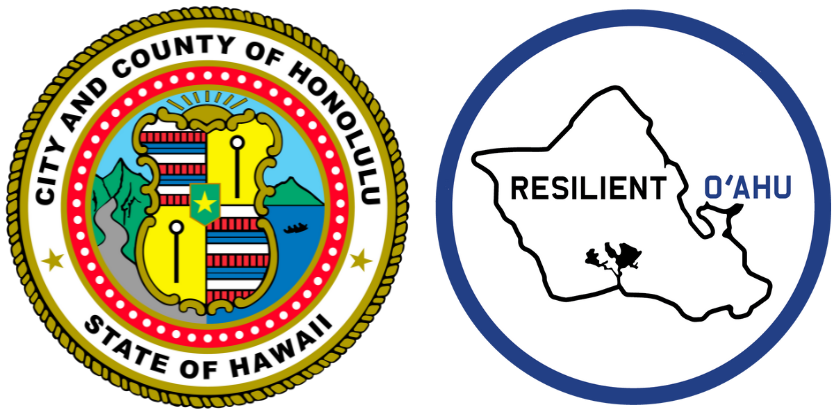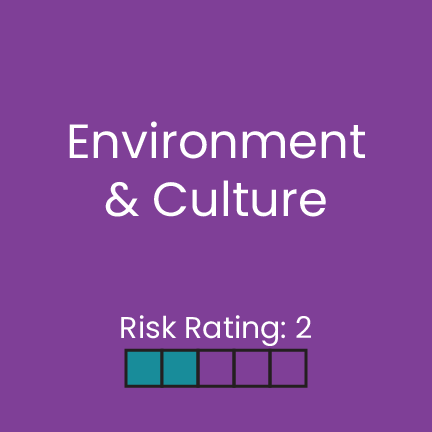Risk Assessment
For best results, please view this page on a computer or tablet.

Hurricanes
While a hurricane has never directly hit the island of Oʻahu, the threat is increasing and a severe storm could still have major consequences.
Damage to infrastructure can lead to community isolation and limited access to health and emergency services.
90% of storm related deaths in Hawaiʻi are attributed to storm surge and most Oʻahu shelters can only withstand up to a Category 1 event.
64.2% of single family homes cannot withstand hurricane winds so many people would be unable to shelter at home.
Disruptions to the harbor, Kakaʻako, or Waikīkī could cost up to billions of dollars in economic impacts.
A disruption to the port would cause a serious limit in food supplies and other essentials for the whole state.
Crop sensitivity to strong winds and flood makes the agricultural industry highly vulnerable following a hurricane.
Those most vulnerable to mental health issues resulting from severe storms are single, male, who have previous mental health issues, or who suffer from addiction.
Mental health issues reported after storms include: behavioral problems in kids, substance abuse and misuse, and increased domestic violence.
Destruction due to a hurricane may cause displacement, leading to cascading mental health impacts.
23,739 buildings, 198 miles of roadway, 183 bridges, 3 fire stations, 5 hospitals, and 10,218 acres of urban land.
Energy utilities will likely be disrupted by high winds, potentially causing widespread and prolonged power outages.
Communication and water infrastructure is vulnerable and would cause cascading impacts, like the inoperability of water treatment plants.
Community cohesion may be threatened by population lost or displacement. An additional threat may be the isolation of communities due to infrastructure failure.
People experiencing houselessness are disproportionately vulnerable and may experience a greater sense of loss of place.
Covid has decreased volunteers to organizations like the Red Cross, limiting available help to frontline communities.
1,464 acres of conservation land are vulnerable to storm surge flooding.
Spills from landfills unable to handle intense rainfall and hazardous fuels, sewage, and household chemical spills would damage the environment.
Eroding beaches and contaminated waters would impact fishing and other cultural practices.
Additional Resources
Central Pacific Hurricane Center
Strengthen your home with the Homeowner’s Handbook
Sign up to receive alerts from HNL Info
Prepare your 14 day Disaster Kit

Drought and Wildfire
A decrease of 60% precipitation is possible by 2050 on the leeward coast, with droughts being the main risks associated with this hazard.
With a decrease in precipitation, there is an increased risk for a decline in water and air quality, as water resources become limited.
A decrease in precipitation causes drought conditions, which increases the threat of wildfires. Wildfires pose great risk to physical health and safety.
The agriculture industry is vulnerable to economic loss, especially farms reliant on springs and mountain water.
Landscaping and maintenance costs will increase impacting public places such as parks and potentially causing a decline in tourism.
Over time, the sustainable yields from aquifers will be diminished, further straining water resources.
With limited water resources, parks and natural places may become less attractive, losing their mental health benefits.
Mental health impacts associated with drought disproportionately affect farmers and agricultural workers.
Low-income, Native Hawaiian, and other communities that grow food on the leeward coast will be disproportionately impacted by the loss of precipitation.
Wildfires caused by droughts are a serious threat to infrastructure.
A diversity of water resources will be required as water costs increase and water availability decreases.
Water shortages are increasingly likely, especially if coinciding with higher temperatures and population growth.
Water rights and security will become more contentious since leeward Oʻahu, is the fastest growing part of the island.
Many low-income and Native Hawaiian communities live on the leeward coast, disproportionately impacting these communities.
Behavioral changes in water usage may be required depending on water availability.
Overall watershed health is likely to decline as streams and vegetation dry out. This may also support a rise in invasive species.
Droughts may impair, diminish, or impeded some traditional and customary practices of Native Hawaiians.
Wildfires caused by drought conditions, threaten vegetation, habitat, and critical species to the ecosystem.

Sea Level Rise &
Coastal Erosion
Sea level rise may reach 3.2 feet by 2050, at which serious damages to infrastructure, the economy, and the environment are likely to occur.
Disruptions to critical infrastructure may prevent or limit access to food, medicine, or other essential commodities.
13,300 people are expected to be displaced on Oʻahu due to sea level rise because of the risk it poses to people in shoreline areas.
Rising sea levels and coastal erosion may impact water utilities near the coast causing an increased risk of water-borne diseases.
Economic impacts will disproportionately impact low lying areas and the low elevation areas of the urban center.
Ewa Beach and Pearl Harbor are major economic concerns because of their coastal location and significance to the economy.
Stress due to managing flooding and flood damages is a likely mental health impact.
Loss of place due to displacement and chronic flooding is a major concern for Native Hawaiian and Polynesian communities.
Mental health resources may be limited since this hazard is not associated with a particular climate shock event.
7,749 buildings, 68.98 miles of roadway, 116 bridges, and 4,613 acres of urban land will be exposed to flooding.
Water and wastewater infrastructure may be degraded by corrosion and experience greater infiltration flows due to rising groundwater levels.
Beach infrastructure is at risk of falling into the ocean.
Forced displacement from communities in low lying areas will impact community cohesion and cause major equity concerns.
Nuisance flooding may be a constant threat to rural communities that are only connected by one road.
Public recreational spaces could be temporarily or permanently closed, limiting community gathering places.
Traditional practices like salt cultivation and fishpond maintenance may be disrupted since 550 cultural sites are expected to be exposed with 3.2’ of sea level rise.
13 miles of Oʻahu’s beaches have already been lost to sea level rise and coastal erosion.
Near shore and low-lying ecosystems will be impacted by saltwater intrusion.

Increase in Temperature
Models predict a possible increase in average temperatures of 2.7 to 4.5°F by 2050, causing more frequent heat waves and contributing to more severe drought and wildfire conditions.
Extreme heat are associated with increased respiratory illnesses, heatstroke, cardiovascular disease, and kidney disease.
The elderly population in Hawaiʻi is expected to increase to 23.8% by 2045, increasing the vulnerable population to heat.
Those who do not have air conditioning in their homes will be more sensitive to extreme heat.
Worker safety, especially for outdoor work, will be increasingly concerning, potentially limiting work hours or increasing break lengths.
Operational costs for energy and other operations across other City departments could increase.
Certain recreation activities may fluctuate in popularity, impacting tourism.
Those without air condition and those that cannot afford to run it, may experience strains on their mental health.
Extreme heat events have been linked to increased suicide risk and emergency department visits.
Blackouts are possible if energy use is increased during extreme heat events.
Extreme heat can impact transportation infrastructure such as roads and tarmacs cracking. Additionally, brush fires resulting from heat may threaten other critical infrastructure.
Building redesigns may be necessary to adapt to increasing temperatures.
Cooling centers are generally more available in affluent areas. Additionally, there may be limited transportation access to cooling centers.
People that commute on foot or by bike may be increasingly uncomfortable, forcing a switch to more expensive transportation modes.
Socializing and recreating outdoors will become increasingly uncomfortable.
Increasing temperatures will stress native fauna and flora leading to their decline.
Tree canopy and landscaping will be stressed because low water levels will limit irrigation.
Extreme heat could cause brush fires, which threaten parks and wildlife.

Flash Flooding
A flash flood is caused by intense precipitation such as multiple inches or more of rain in one hour. They can also be very localized and different factors will impact their severity.
It is unlikely that there will be warnings for rain bombs because they are very difficult to predict. Therefore, impacts from flash flooding and landslides may be more deadly.
Energy utilities may be disrupted causing power outages, which impose health risks.
Historically, floods have caused millions of dollars in damages. The localized nature of the events will make the impacts more devastating in some areas than others.
Agriculture is particularly vulnerable because of crop sensitivity to flooding.
Damaged transportation infrastructure may prevent people from commuting to their work place.
Forced displacement due to flooding and other related hazards will cause mental health impacts.
Rain bombs may limit or prevent access to public, recreational places, limiting their mental health benefits.
Intense rains clog storm drains with debris, which would require cleaning to mitigate future flooding.
The likelihood of a landslide increases with a rain bomb event. There are 66 highway sites that have been identified as vulnerable to landslides.
Disrupted energy utilities could cause prolonged power outages, limiting the City’s ability to switch over to an electric bus fleet.
Flooded roads without warning have the ability to isolate communities.
People experiencing houselessness are disproportionately vulnerable and may experience a greater sense of loss of place.
Spills from landfills unable to handle intense rainfall and hazardous fuels, sewage, and household chemical spills would damage the environment.
Debris clogged streams could cause more environmental and habitat devastation.






























